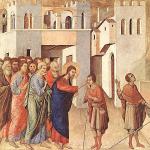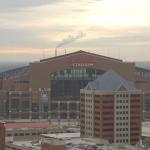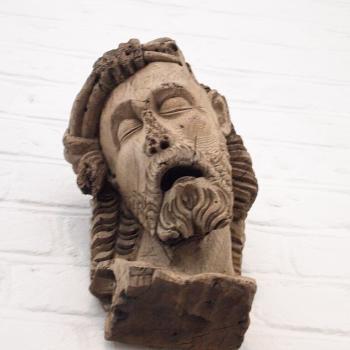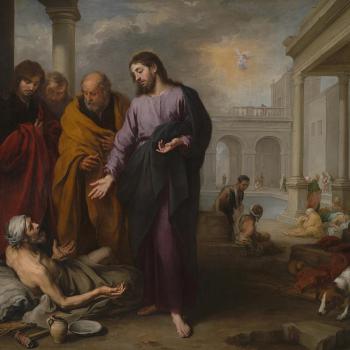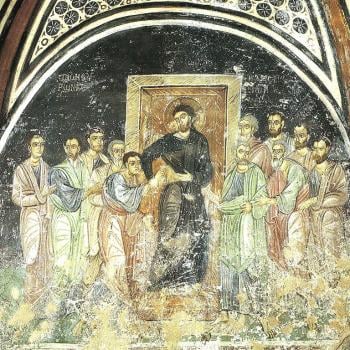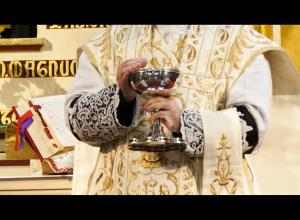
Christ’s physical or corporeal presence is the presence which he had when he lived among us in the world, that is, the presence he had with us before his ascension. He had a physical body which people could see and touch, that is, one which was not hidden from them. The sacramental presence is the presence of Jesus in the eucharist. It is the presence of his which lies hidden from the senses. It does not come to us in a form composed of parts, but rather as one unified whole, indicating that its nature is not physical, because if it were physical, it would follow the rules of material being, which includes the way material being can be and is divided into parts. This is why, no matter how much communion we partake, we receive the exact same thing: Jesus, in all his glory. Thus, as Peter Lombard explained, Christ’s true body is invisible, even though when we partake or communion, we partake of something physical, something which comes to us in the form of bread and wine and not Christ’s physical body:
WHY CHRIST’S FLESH IS CALLED INVISIBLE. And so Christ’s body is to be understood to be “in one place,” namely visible in the human form; but his truth, that is, his divinity, is everywhere. His truth, that is, his true body, is on every altar wherever the Eucharist is celebrated. In the same way is also to be understood that text: You will always have the poor with, you; you will not always have me with you, namely according to the corporeal presence in which he lived with them. – Similarly, ‘he is in heaven insofar as he is man’: namely, visibly; but invisibly he is on the altar, because he does not appear in human form, but is veiled by the form of bread and wine. That is why his flesh is called invisible: it is truly on the altar, but because it does not appear in its own species, it is called invisible.[1]
While what we receive is not bread and wine, it comes to us in the appearance of such. This is not without value, for in and through the physical appearance, we are given a sign which indicates what it is which we truly receive, that is, the bread of life, Christ himself:
And so the invisible flesh is said to be the sacrament of the visible flesh, because the species of the bread, according to which it seems not to be flesh, is the sacrament of the visible flesh. But the invisible flesh, that is, the species, according to which Christ’s flesh appears not to be flesh, is signified by the body of Christ, which is visible and palpable when it appears in its own form.[2]
The sacrament is said to be what we receive physically, while the reality or the thing of the sacrament is what lies behind our perception, that is, the thing of the sacrament itself. We can receive the thing of a sacrament in ways beyond their normative sacramental: God is not bound by the sacrament. Nonetheless, we believe, due to God’s promises, God will use the sacraments to present to us and give us the reality or the thing of the sacraments themselves, which for the eucharist, is Christ himself:
The sacrament and not the thing is the visible species of bread and wine; the sacrament and thing is Christ’s own flesh and blood; the thing and not the sacrament is his mystical flesh. – Moreover, that visible species is a sacrament of a double thing, because it signifies either thing, and bears the express likeness of each of the two. For just as bread restores and sustains the body more than other foods, and wine gives joy to and inebriates man, so the flesh of Christ, more than other graces, spiritually restores and nourishes the interior man; hence: Your chalice inebriates; how magnificent it is! – It also has the likeness of a mystical thing, which is the unity of the faithful, because, just as one loaf of bread is made from many grains, and wine flows into one from many grapes, so the unity of the Church is composed out of the many persons of the faithful.[3]
This is why the real presence is said to be the sacramental presence instead of the physical presence of Christ. For what we partake of physically, the sacrament, is physically bread and wine, even if the reality of what we receive is not bread and wine but Christ himself. And while the sacrament is for our own benefit, to help us grow in grace and be deified, it does so by having us transformed by it into the body of Christ, just as the bread and wine was transformed into Christ, as George Maloney explained:
Thus, we see how the Eucharist not only sacramentally symbolizes, but also effects what it symbolizes. In the memorial of Christ’s passion, death, and resurrection, we enter into His perfect sacrifice, effected once on Calvary, but now extended as we become one Body, sharing the very body and blood of Christ.[4]
We become what we eat. We become Christ. We share with him his life and death, that means, we share with him his sacrifice as we become united with him. And just as we share in his sacrifice, so we also experience his resurrection, his victory over death, in and through our union with him. The eucharist, therefore, not only brings us the sacramental presence of Christ, the real presence, it also has those who partake of it become the means by which Christ’s presence in the world can be and is further experienced. For, once they have joined themselves to Christ, they should live out their lives realizing the full implication of their union with him, bringing Christ’s mystical presence to the world, encouraging others and helping them the same way Christ encouraged and helped those he met.
[1] Peter Lombard, The Sentences. Book 4: On the Doctrine of Signs. trans. Giulio Silano (Toronto: Pontifical Institute of Medieval Studies, 2010), 51 [dist. X c.1.5].
[2] Peter Lombard, The Sentences. Book 4: On the Doctrine of Signs, 52 [dist. X c.1.8].
[3] Peter Lombard, The Sentences. Book 4: On the Doctrine of Signs,, 45 [dist. VIII c.7.2].
[4] George A. Maloney, SJ, Communion of Saints (Hauppauge, NY: Living Flame Press, 1988), 145.
Stay in touch! Like A Little Bit of Nothing on Facebook.
If you liked what you read, please consider sharing it with your friends and family!
N.B.: While I read comments to moderate them, I rarely respond to them. If I don’t respond to your comment directly, don’t assume I am unthankful for it. I appreciate it. But I want readers to feel free to ask questions, and hopefully, dialogue with each other. I have shared what I wanted to say, though some responses will get a brief reply by me, or, if I find it interesting and something I can engage fully, as the foundation for another post. I have had many posts inspired or improved upon thanks to my readers.


